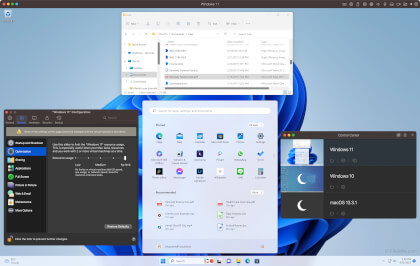Parallels Desktop for Mac
| Version | 26(as of 8/28/2025) |
| Platform | Mac |
| License | Commercial |
| Category | System |
Main Features
- Support for multiple versions of Windows, macOS, and Linux OSs, including Windows 11 (25H2) and macOS Tahoe (26)
- Quickly set up your virtual machines with just a couple of clicks
- Transfer files and copy and paste data between macOS and VM OSs
- Connect plug-and-play USB devices, such as flash drives, printers, and mobile devices
- Sign into a guest Windows operating system with Apple Touch ID
- Capture VM snapshots, revert to saved states, and manage VM storage space directly from macOS
- Use Toolbox utilities to take screenshots, record video and audio, archive files, and more
- Create isolated environments and manage macOS, Windows, and Linux virtual machines with the Visual Studio Code extension
Software Overview
Parallels Desktop for Mac is a virtualization application that allows Intel- and Apple silicon-based Mac users to run Windows, Linux, and other operating systems alongside macOS. It is available in Standard, Pro, Business, and Enterprise editions, providing flexibility for home, education, and business use.
The software runs as a virtual machine (VM) within macOS, letting users access files, copy and paste text across systems, and connect USB devices between macOS and their VMs. Users can also choose to run VMs in windowed, side-by-side, or full-screen modes depending on their workflow needs.
Parallels Desktop provides enhanced compatibility, supporting a wide range of operating systems. On Intel Macs, it can run over 60 OSs, including Windows 2000 through 11, multiple macOS versions, and several Linux distributions. On Apple Silicon Macs, it supports Windows 11, recent macOS versions, including Tahoe and Sequoia, and popular Linux distributions, such as Ubuntu, Fedora, and Debian.
Parallels also includes tools to pause, suspend, or snapshot VMs, manage disk space, and perform quick tasks with the Parallels Toolbox, which offers features like screen recording, file archiving, video conversion, and GIF creation. It also supports Bluetooth controllers, making it useful for gaming.
Summary
Parallels Desktop for Mac offers an easy way to run Windows, Linux, and other operating systems without leaving macOS. It is flexible, integrates smoothly with macOS, and supports a wide range of workflows, making it an excellent option for users who need access to multiple OSs on one machine.
Primary File Type
Supported File Types
| Extension | File Type |
|---|---|
| .PVM | Parallels Virtual Machine |
| .FDD | Parallels Desktop Floppy Disk Image File |
| .HDD | Parallels Desktop Hard Disk |
| .HDS | Parallels Desktop Hard Disk File |
| .ISO | Disk Image File |
| .MACVM | Parallels Virtual Machine (Virtualization Framework Based) |
| .MEM | Parallels Desktop Memory Dump File |
| .PVC | Parallels Desktop Copied Configuration File |
| .PVM | Parallels Virtual Machine |
| .PVMP | Parallels Packed Virtual Machine |
| .PVMZ | Parallels Compressed Virtual Machine |
| .PVS | Parallels Desktop Configuration File |
| .SAV | Parallels Desktop Saved State Image File |
Additional Related File Types
| Extension | File Type |
|---|---|
| .BAT | DOS Batch File |
| .CMD | Windows Command File |
| .COM | DOS Command File |
| .DEV | Windows Device Driver File |
| .DMG | Apple Disk Image |
| .EXE | Windows Executable File |
| .IMG | Disc Image Data File |
| .INI | Windows Initialization File |
| .LNK | Windows Shortcut |
| .MSSTYLES | Windows XP Style |
| .SYS | Windows System File |
| .VBOX | Oracle VM VirtualBox Settings File |
| .VMC | Windows Virtual Machine Configuration File |
| .VMDK | Virtual Machine Disk File |
| .VMWAREVM | VMware Fusion Virtual Machine |
| .VMX | VMware Virtual Machine Configuration File |
| .VPC6 | Virtual PC 6 Machine Package |
| .VPC7 | Virtual Machine Package |
| .WPX | Printer Description File |
